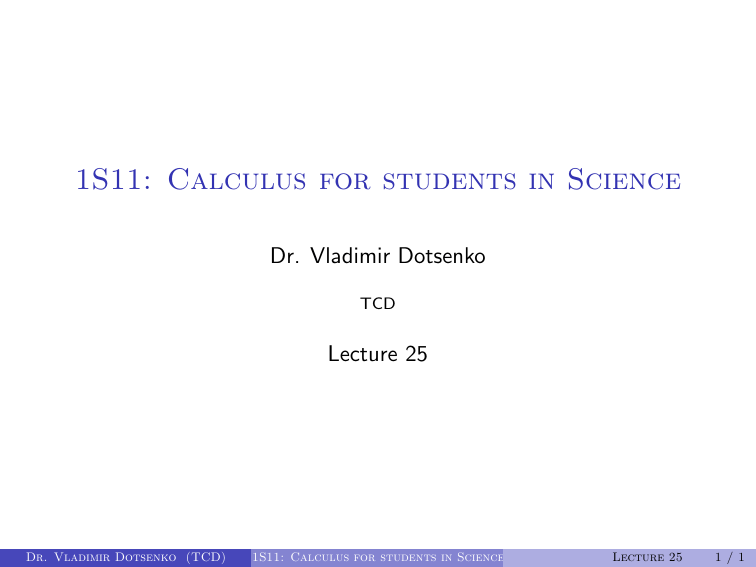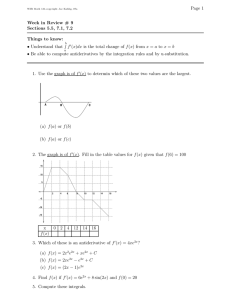1S11: Calculus for students in Science Dr. Vladimir Dotsenko Lecture 25 TCD
advertisement

1S11: Calculus for students in Science Dr. Vladimir Dotsenko TCD Lecture 25 Dr. Vladimir Dotsenko (TCD) 1S11: Calculus for students in Science Lecture 25 1/1 Antiderivatives: reminder It is often important for applications to solve the reverse problem: assume that we know the derivative of a function, what can we say about the original function? For example, we see the instantaneous velocity on the speedometer all the time, and want to know how far we progressed over the given period of time. Definition. A function F is called an antiderivative of the given function f if dF (x) = f (x). dx Suppose that F1 and F2 are two antiderivatives of the same function f . Then dF1 (x) dF2 (x) d(F1 (x) − F2 (x)) = − = f (x) − f (x) = 0, dx dx dx which implies that F1 (x) − F2 (x) is a constant c. Vice versa, if F is an antiderivative of f , then G (x) = F (x) + c is also an antiderivative of f . Dr. Vladimir Dotsenko (TCD) 1S11: Calculus for students in Science Lecture 25 2/1 Integral calculus: antiderivatives There is an alternative “integral” notation for antiderivatives: Z f (x) dx = F (x) + C R denotes the fact that F is an antiderivative of f . The expression f (x) dx on the left side of that equation is called the indefinite integral. Examples. Some examples of indefinite integrals are shown below: derivative formula (x 2 )′ = 2x (sin x)′ = cos x (tan x) = cos12 x (ln x)′ = 1 n+1 ′ x x = xn n+1 Dr. Vladimir Dotsenko (TCD) equivalent integration formula R 2 R 2x dx = x + C cos x dx = sin x + C R dx 2 x = tan x + C Rcosdx x = ln x + C R n n+1 x dx = xn+1 + C 1S11: Calculus for students in Science Lecture 25 3/1 Rules for antiderivatives Theorem. Suppose that F (x) and G (x) are antiderivatives of f (x) and g (x) respectively, and that c is a constant. Then R cf (x) dx = cF (x) + C , R [f (x) + g (x)] dx = F (x) + G (x) + C , R [f (x) − g (x)] dx = F (x) − G (x) + C . Proof. Just use rules for differentiation. For example, (F (x) − G (x))′ = F ′ (x) − G ′ (x) = f (x) − g (x). Another way to write the same is R R cf (x) dx = c f (x) dx, R R R [f (x) + g (x)] dx = f (x) dx + g (x) dx, R R R [f (x) − g (x)] dx = f (x) dx − g (x) dx. Dr. Vladimir Dotsenko (TCD) 1S11: Calculus for students in Science Lecture 25 4/1 Rules for antiderivatives These rules should be handled with care, leaving the arbitrary constant till the very end of the computation, so that we do not write anything like that 2 Z Z x 2 x + C = 2x dx = 2 x dx = 2 + C = x 2 + 2C , 2 concluding then that C = 2C , so C = 0. Of course, there is a more general rule which combines addition and multiplication by constants: Z [c1 f1 (x) + c2 f2 (x) + · · · + cn fn (x)] dx = Z Z Z = c1 f1 (x) dx + c2 f2 (x) dx + · · · + cn fn (x) dx. Dr. Vladimir Dotsenko (TCD) 1S11: Calculus for students in Science Lecture 25 5/1 Rules for antiderivatives Theorem. (u-substitution) Suppose that F (x) is an antiderivative of f (x). Then Z [f (g (x))g ′ (x)] dx = F (g (x)) + C . Proof. Applying the chain rule, we obtain (F (g (x)))′ = F ′ (g (x))g ′ (x) = f (g (x))g ′ (x), as required. Example. Let us evaluate the integral Z (x 2 + 1)50 · 2x dx. Let g (x) = x 2 + 1. Noticing that (x 2 + 1)′ = 2x, we can write the integral as Z Z (x 2 + 1)51 g (x)51 2 50 +C = + C. (x + 1) · 2x dx = g (x)50 g ′ (x) dx = 51 51 Dr. Vladimir Dotsenko (TCD) 1S11: Calculus for students in Science Lecture 25 6/1 u-substitution: more examples Example. Let us evaluate the integral Z cos x dx. sin2 x Denoting g (x) = sin x, we get Z Z cos x 1 1 1 +C =− + C. g ′ (x) dx = − dx = 2 2 g (x) g (x) sin x sin x Example. Let us evaluate the integral √ Z cos x √ dx. x √ Denoting g (x) = x, we get √ Z Z √ cos x √ dx = cos g (x) · 2g ′ (x) dx = 2 sin g (x) + C = 2 sin x + C . x Dr. Vladimir Dotsenko (TCD) 1S11: Calculus for students in Science Lecture 25 7/1 Rules for antiderivatives We already know that differentiating products is not as easy as differentiating sums. Same is true for antiderivatives. Theorem. (Integration by parts) Suppose that F (x) and G (x) are antiderivatives of f (x) and g (x) respectively. Then Z Z [f (x)G (x)] dx + [F (x)g (x)] dx = F (x)G (x) + C . Proof. Applying the product rule, we obtain (F (x)G (x))′ = F ′ (x)G (x) + F (x)G ′ (x) = f (x)G (x) + F (x)g (x), as required. This rule is usually applied in the following way: Z Z [f (x)G (x)] dx = F (x)G (x) − [F (x)g (x)] dx, meaning that computing the antiderivative of f (x)G (x) can be reduced to computing the antiderivative of F (x)g (x), and the latter one can be substantially simpler to compute. Dr. Vladimir Dotsenko (TCD) 1S11: Calculus for students in Science Lecture 25 8/1 Integration by parts: examples R Example. Let us evaluate xe x dx. Using integration by parts with G (x) = x, f (x) = e x (in which case g (x) = 1, and we can take F (x) = e x ), we get Z Z x x xe dx = xe − e x · 1 dx = xe x − e x + C . Note that if we instead apply integration by parts with f (x) = x, 2 G (x) = e x (so that F (x) = x2 , g (x) = e x ), we get Z x2 xe dx = e x − 2 x Z x2 x e dx, 2 and our computation expressed the given integral using what is a more complicated indefinite integral! Dr. Vladimir Dotsenko (TCD) 1S11: Calculus for students in Science Lecture 25 9/1 Integration by parts: examples R Example. Let us evaluate x 2 e x dx. Using integration by parts with G (x) = x 2 , f (x) = e x (in which case g (x) = 2x, and we can take F (x) = e x ), we get Z Z 2 x 2 x x e dx = x e − 2xe x dx = x 2 e x − 2xe x + 2e x + C , R since we already know xeRx dx. Example. Let us evaluate ln x dx. Using integration by parts with G (x) = ln x, f (x) = 1 (in which case g (x) = x1 , and we can take F (x) = x), we get Z Z 1 ln x dx = x ln x − x · dx = x ln x − x + C . x Dr. Vladimir Dotsenko (TCD) 1S11: Calculus for students in Science Lecture 25 10 / 1 Integration by parts: examples R Example. Let us evaluate e x sin x dx. Using integration by parts with G (x) = sin x, f (x) = e x (in which case g (x) = cos x, and we can take F (x) = e x ), we get Z Z x x e sin x dx = e sin x − e x cos x dx. Now we use integration by parts with G (x) = cos x, f (x) = e x (in which case g (x) = − sin x, and we can take F (x) = e x ), so that we get Z Z x x e cos x dx = e cos x + e x sin x dx, so that R R e x sin x dx = e x sin x − e x cos x − e x sin x dx, and Z 1 e x sin x dx = (e x sin x − e x cos x) + C . 2 Dr. Vladimir Dotsenko (TCD) 1S11: Calculus for students in Science Lecture 25 11 / 1







